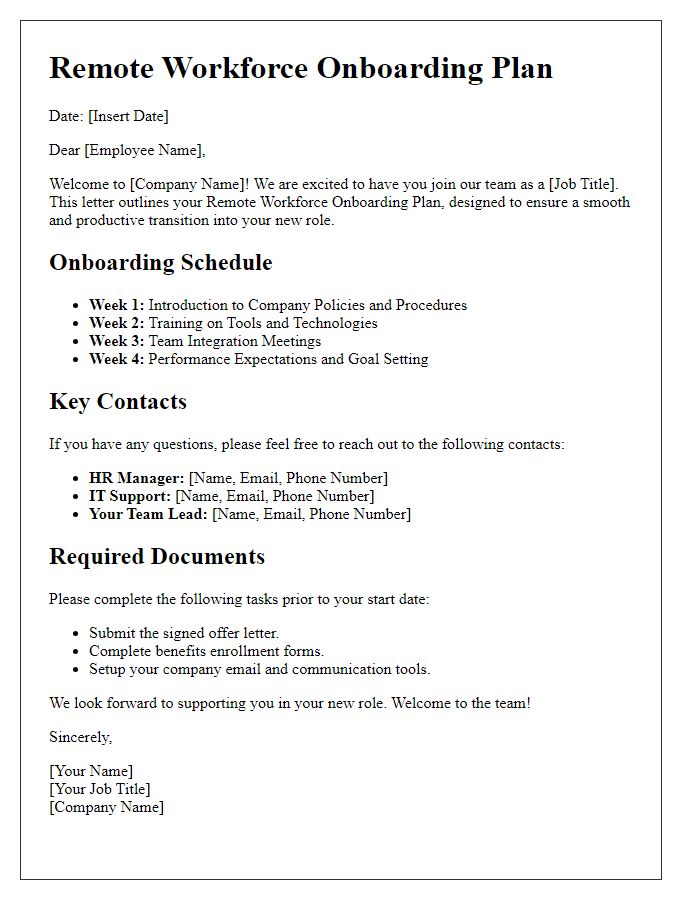Starting a new job remotely can feel overwhelming, but a well-organized onboarding checklist can make all the difference. It's essential to provide new employees with the necessary resources and support to help them feel welcomed and prepared for their new role. From setting up technology to introducing team dynamics, each step plays a crucial part in their successful transition. Ready to learn how to create an effective remote onboarding checklist? Let's dive in!

Personalized Welcome Message
A personalized welcome message can significantly enhance the remote onboarding experience for new employees, fostering a sense of belonging and excitement. This message typically includes the employee's name, welcoming them to the organization (for example, "Welcome to ABC Corporation, a leader in technology solutions"), and outlining the team's mission (such as delivering innovative products and exceptional service). It might also reference the start date (e.g., "We are thrilled to have you join us starting on October 15th") and introduce key team members, such as their manager or colleagues they will work closely with. Additionally, it may provide a brief overview of the company's core values and culture (e.g., integrity, collaboration, and innovation) alongside instructions for the first-day agenda, ensuring seamless integration into the team.
Onboarding Schedule and Agenda
An effective onboarding schedule is essential for a smooth integration of new employees into a remote work environment. The onboarding agenda typically spans the first couple of weeks, outlining key activities designed to familiarize new hires with company policies, tools, and team dynamics. Day one may include welcome sessions via video conferencing platforms like Zoom, introduction to the team, and an overview of the company's mission statement. Follow-up sessions may cover topics such as compliance training, where employees learn about data protection regulations like GDPR, and technical training on collaboration tools like Slack and Trello. By week two, the focus often shifts to specific job responsibilities, performance expectations, and setting up one-on-one meetings with team leads to discuss individual goals. Ongoing support and regular check-ins can foster a sense of belonging and ensure alignment with company culture in this virtual landscape.
Essential Software and Tools Access
Effective remote onboarding necessitates comprehensive access to essential software and tools. Each new hire must ensure installation of communication platforms such as Slack (a real-time messaging tool used by millions), video conferencing software like Zoom (which hosted over 300 million daily meeting participants in 2020), and project management applications such as Trello or Asana, both of which facilitate task tracking and team collaboration across various projects. Additionally, access to cloud storage services, such as Google Drive or Dropbox, is critical for document sharing and collaboration, with Google Drive alone boasting over 1 billion active users. Security software, including VPNs (Virtual Private Networks) for safe internet browsing, and antivirus programs, must be downloaded, ensuring data protection in remote work environments. Comprehensive login credentials for company-specific software, like CRM tools (Customer Relationship Management), will enable new employees to start efficiently in their roles. A thorough checklist will guarantee that all necessary software and tools are readily available, fostering a seamless onboarding experience.
Company Policies and Guidelines
The remote onboarding checklist is essential for new employees to understand the company's policies and guidelines effectively. Key documents include the Employee Handbook, which outlines workplace expectations, and the Code of Conduct, detailing ethical behavior requirements. Training modules on usage of collaborative tools, such as Zoom and Slack, enhance communication skills within the virtual workspace. Moreover, familiarity with security protocols, like password management and data protection measures, is crucial for safeguarding company information. Furthermore, understanding the company culture through virtual meet-and-greet sessions allows new hires to engage with their colleagues and the organizational mission, promoting a cohesive team environment.
Team Introduction and Communication Channels
A comprehensive team introduction is essential for effective remote onboarding, fostering a collaborative atmosphere among new hires and existing team members. Key communication channels, such as Slack (used by over 12 million daily users) for real-time messaging, email via Microsoft Outlook with features for task management, and Zoom for virtual meetings, should be clearly outlined to streamline interactions. Additionally, team members can utilize project management tools like Trello, which organizes tasks visually, enhancing transparency on project status. A shared team document, stored in Google Drive, can serve as a living resource for onboarding materials, crucial contacts, and frequently asked questions, ensuring that new employees have easy access to vital information. Regular check-in meetings, scheduled bi-weekly or as preferred, will provide opportunities for new hires to ask questions and receive feedback, fostering an inclusive remote working environment.













Comments